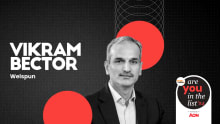Catching-up with Change Management Guru Curt Coffman

Statistically, the macro-level constituents of a company, i.e. the senior leadership and management influence only 14% of the culture at the workplace
“If you change the way you look at things, the things you look at change.” – Wayne Dyer
As change management guru, Curt Coffman talked about his book – ‘Culture Eats Strategy for Lunch: the Secret of Extraordinary Results’ co-authored with Kathie Sorenson, the audience at the NHRDN conference in New Delhi, was forced to don its thinking-hat. In a thought-provoking start, Curt mentioned Galileo as being the only one who used the telescope for the right purpose; even though he wasn’t really the one who invented it. This subtlety and its resultant difference set the tone for the engrossing discussion that followed in the next hour and a half.
Curt Coffman is a New York Times bestselling author, a researcher and a management consultant for many top companies across the globe. With over 30 years of experience in deciphering what goes into creating a high-performance culture in a corporate, he believes that – culture at the workplace affects business in multiple ways. Hence, culture could become a company’s greatest competitive advantage or even harness its worst nightmare.
The Macro-Micro Bridge
Statistically, the macro-level constituents of a company, i.e. the senior leadership and management influence only 14% of the culture at the workplace. The micro constituents – the company’s employee pool; affects to a major extent of 45 percent; closely followed by the ‘bridge-folks’ – the people managers; who attribute for a significantly 40 percent. These numbers would surely make sense to the CEO of a company when he envisages himself at the execution points of the corporate hierarchy. Importance of people at all levels is as relevant to the success of a company, as is the importance of the product created by it. Managers who take care of employees at these levels are the bridge-builders between the macro and micro constituents of a firm. In conclusion to the statistics illustrated, Curt observed that ensuring a constant boost at the workplace is what helps the organization and its people grow.
‘Weakness Prevention: Excellence Promotion’
Quality is measured by the number of defects in a process. In a people process, the defects typically are the weaknesses of the people involved. HR managers often focus on these weaknesses of individuals working in the organization. Bringing a twist to the approach, Curt stressed on the value of building on the natural capacities of an individual. “Igniting purpose and creating a unique culture with constant energizing can take a company to newer heights” said Curt. The preventive approach to working with your people is not the most effective way to achieve growth in numbers was the advice. An employee should be able to channelize his/her energies in the most productive way at work and not outside of work and that is what HR should aim for.
Preserving, Nurturing and Managing Talent
Curt further professed three cogent solutions for the issue of talent management. First being – finding the right fit. He said that this is the most talked-about philosophy while hiring; but often an employee doesn’t turn-out to be the rightmost fit for the job. In such a scenario, figuring out the abilities of the employee is extremely important. Cross-leveraging their people’s skill-sets should come naturally to people managers of today. The second solution that Curt provided was – ‘competent partnering’. He skillfully explained how ‘partnering at the workplace’ is the most constructive way to achieve business growth. “Talking about someone you have a problem with does not solve a problem; talking to that person does” was the suggested approach, for resolving the third and big issue of communication. Curt extended this remark to speak about the transparency factor. He exclaimed that being transparent is needed since it provides clarity in thought and action, but leadership should be careful so as to avoid any kind of chaos or confusion.
In conclusion:
Through his vast experience of having worked in diverse cultures Curt noted, “It’s the congruence of financial performance; customer performance and individual performance that leads to success in business.” An avid fan of the movie Slumdog Millionaire; Curt ended by saying that circumstances can only influence one’s aspirations to a certain extent; it is one’s learning proclivity and experiential upbringing that eventually make for that striking difference!











